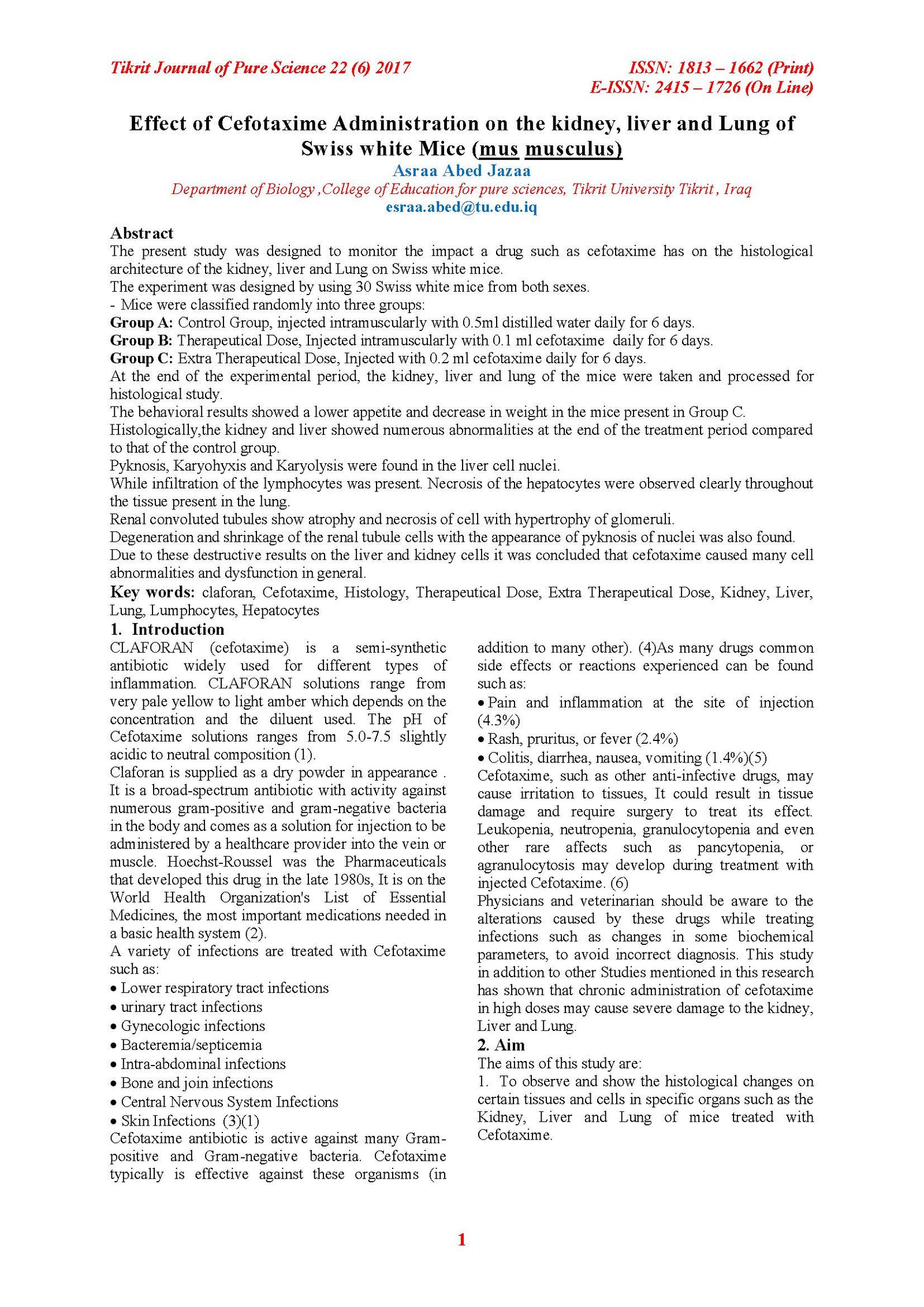Effect of Cefotaxime Administration on the kidney, liver and Lung of Swiss white Mice (mus musculus)
Main Article Content
Abstract
The present study was designed to monitor the impact a drug such as cefotaxime has on the histological architecture of the kidney, liver and Lung on Swiss white mice.
The experiment was designed by using 30 Swiss white mice from both sexes.
- Mice were classified randomly into three groups:
Group A: Control Group, injected intramuscularly with 0.5ml distilled water daily for 6 days.
Group B: Therapeutical Dose, Injected intramuscularly with 0.1 ml cefotaxime daily for 6 days.
Group C: Extra Therapeutical Dose, Injected with 0.2 ml cefotaxime daily for 6 days.
At the end of the experimental period, the kidney, liver and lung of the mice were taken and processed for histological study.
The behavioral results showed a lower appetite and decrease in weight in the mice present in Group C.
Histologically,the kidney and liver showed numerous abnormalities at the end of the treatment period compared to that of the control group.
Pyknosis, Karyohyxis and Karyolysis were found in the liver cell nuclei.
While infiltration of the lymphocytes was present. Necrosis of the hepatocytes were observed clearly throughout the tissue present in the lung.
Renal convoluted tubules show atrophy and necrosis of cell with hypertrophy of glomeruli.
Degeneration and shrinkage of the renal tubule cells with the appearance of pyknosis of nuclei was also found.
Due to these destructive results on the liver and kidney cells it was concluded that cefotaxime caused many cell abnormalities and dysfunction in general.
Article Details

This work is licensed under a Creative Commons Attribution 4.0 International License.
Tikrit Journal of Pure Science is licensed under the Creative Commons Attribution 4.0 International License, which allows users to copy, create extracts, abstracts, and new works from the article, alter and revise the article, and make commercial use of the article (including reuse and/or resale of the article by commercial entities), provided the user gives appropriate credit (with a link to the formal publication through the relevant DOI), provides a link to the license, indicates if changes were made, and the licensor is not represented as endorsing the use made of the work. The authors hold the copyright for their published work on the Tikrit J. Pure Sci. website, while Tikrit J. Pure Sci. is responsible for appreciate citation of their work, which is released under CC-BY-4.0, enabling the unrestricted use, distribution, and reproduction of an article in any medium, provided that the original work is properly cited.
References
1. Renaud, (2014). CLAFORAN, Version 6.0. Sanofi-aventis Canada Inc.2905 Place Louis-R-Renaud, Laval, Quebec H7V 0A3
2. "WHO Model List of Essential Medicines" (PDF). World Health Organization. October 2013.
3. Scriabine A.(1999). Pharmaceutical Innovation: Revolutionizing Human Health. Pennsylvania: Chemical Heritage Foundation. p. 169.
4. Simmons BP, Gelfand MS, Grogan J. (1995). Cefotaxime twice daily versus ceftriaxone once daily. A randomized controlled study in patients with serious infections. Diag.Microb.& Inf. Dis.22 (1–2): 155–7.
5. U.S. Food and Drug Administration. U.S. Department of Health and Human Services. Claforan Sterile (cefotaxime for injection, USP) and Injection (cefotaxime injection, USP). 19 June 2009.
6. Peker E, Cagan E, Dogan M. Ceftriaxone-induced toxic hepatitis. World J Gastroenterol 2009;15:2669-71.
7. Riviere J., Papich M. & Adams H., (2011). Veterinary Pharmacology and Therapeutics. (9th ed.) Wiley-Blackwell, A John Wiley&Sons Inc., Publication. USA.
8. Scholz H., Hofmann T., Noack R. (1998). Prospective comparison of ceftriaxone and cefotaxime for the short-term treatment of bacterial meningitis in children.US National Library of Medicine Microbiology and Hygiene, Berlin, Germany.
9. Woodfield JC, Van Rij AM, Pettigrew RA,(2003). A comparison of the prophylactic efficacy of
ceftriaxone and cefotaxime in abdominal surgery. Amer.J.Surg. 185 (1)
10. Gums JG, Boatwright DW, Camblin M, (2008). Differences between ceftriaxone and cefotaxime: microbiological inconsistencies. The Annals of Pharmacotherapy 42 (1): 71–9. Coombes JD (1982). "Metabolism of cefotaxime in animals and humans". Reviews of Infectious Diseases 4 (Suppl 2): S325–32.
11. Ahmed T.S. (2010). Histological characteristics of thyroid gland induced by carbimazole in albino mice Mus musculus and their pups. Tikrit, Iraq. pp:83-89
12. Eroschenko V., (2005). Atlas of Histology. 10th Edition, Lippincott Williams & Wilkins. USA.
13. Elsayed MG, Elkomy AA, Aboubakr MH. Hepatotoxicity evaluation in albino rats exposed to ceftriaxone. Asian J Pharm Biol Res 2011;1:145-50
14. Peker E, Cagan E, Dogan M. Ceftriaxone-induced toxic hepatitis. World J Gastroenterol 2009;15:2669-71. 15. Soliman A. Hepato-renal effect of cefotaxime in albino rats. Department of Pharmacology, Faculty of Veterinary Medicine, Cairo University, Cairo, science Journal.2015. 16. Hayashi T, Maruden A, Irimura K. Nephrotoxicity of cefodizime sodium in rats-single and 14-day repeated intravenous administration. J Toxicol Sci 1988;13:285-327. 36. 17. Effect of cefodizime sodium on the kidney function in male rabbits single and 7-day repeated intravenous administration. J Toxicol Sci 1988;13: 329-60.
